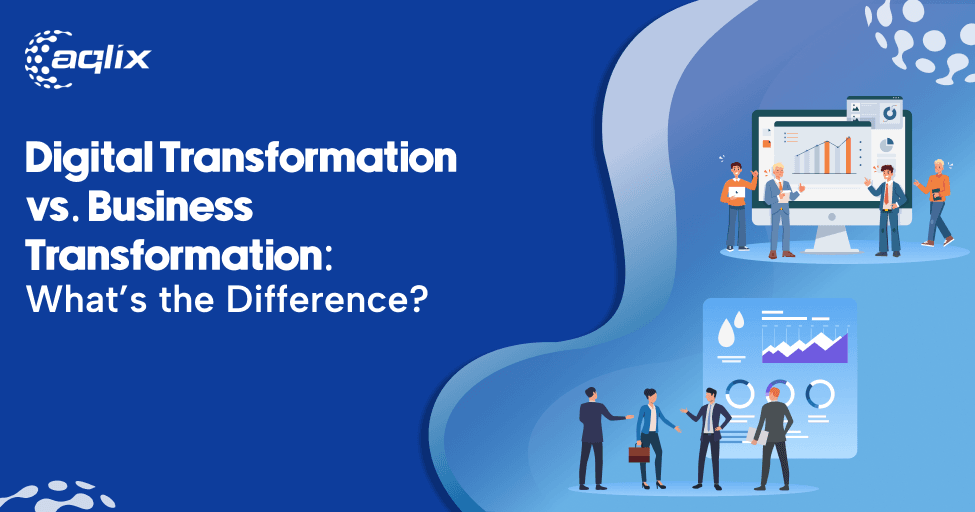Transformation has quickly become a central topic of company’s conversations in recent years. Thought leaders in many industries tell us we must change, adapt and remain competitive in an increasingly hostile world. But in most companies, business transformation and digital are used interchangeably. This is super confusing and results in hazy, rudderless product strategy.
Although the two are related, they are of different theoretical purposes. Understanding this difference helps the companies line up technology investments with overall strategic objectives. When realized well, transformation should enable long-term growth, operational resilience and greater customer value.
This article discusses the key differences between business transformation and digital transformation, how they relate to one another balance out, and why you should choose both in tandem. We’ll also refer to the practical ways in which modern enterprises are going about this and how organizations like Aqlix IT Solutions support an organized, sustainable approach.

Defining Business Transformation
Business transformation involves significant alterations within an organisation, covering structure, culture, operations and value delivery. It looks at how the company works deep down, and how deeply embedded are its responses in a changing market landscape. Business modernization is about more than just the technology. Rather, it involves re-examining leadership models, transforming key organisational processes and shifting organisation priorities.
Such an overhaul frequently requires re-examining the purpose, strategic orientation and operating models of the company. That may mean moving away from traditional top-down decision-making to more nimble and collaborative models. It also might nudge business toward more customer-focused models, emphasizing agility and personalization of service.
Company “particular” changes are commonly the result of conditions of market, regulations, competition or business opportunity that demand business transformation. For instance, a product-driven company may shift to a service-based model in order to attempt building long-term value and relationships.
Key Characteristics of Business Transformation
End-To-End Business transformation is about more than just the business. It impacts people, workflow and long-term strategy. The aim is to build a business model that is robust, flexible and fits well with current and future market requirements.
A few common examples include:
- Transitioning from traditional leadership to agile decision making
- Rethink journey frameworks to be about the customer experience, not just purchases
- Realigning teams for greater collaboration and less silos_orientation of operation
The Transformationist But transformation is about more than just structure, it’s also about a certain type of culture. For transformation to work, employees need to accept new methods.
Defining Digital Transformation
Digital transformation is about using the technology to improve methods of doing things and optimize operations, so people can make smarter decisions. This is a technology-enabled transformation that enables efficiency, connection and scale. Digital transformation is a catalyst for greater business strategy, but it doesn’t automatically change the business strategy.
The digital journey entails harnessing cloud platforms, automation tools, AI-infused analytics and business systems for example. These technological advancements systematize operations, ease workloads and enable organizations to function in more correctness and swiftness.
The reason for digital transformation in most of the companies is antiquated legacy systems, disintegrated departments, ineffective manual processes. How modernizing these facilitates clarity around – and visibility into the workings of – an entire organization.
Examples of Digital Transformation Initiatives
Digital transformation projects vary according to their scope and the needs and scale of the organization. Some common examples include:
- Rolling with the flow: Using workflow automation to reduce monotonous tasks.
- Moving applications and data to the cloud for convenient access and scale.
- Leveraging AI analytics for data-driven strategic decisions and in the moment insights
- Adoption of enterprise wide systems to encourage cross departmental cooperation
Digital transformation enhances capability. It changes the way business gets done, but it doesn’t dictate what business priorities should be. But business transformation still provides strategic direction.
How They Differ and Tie Together
Business transformation and digital transformation. Two sides of the same coin Although they are closely related, business Transformation and Digital Transformation are not always one and the same thing. However, the two are interdependent. Strategy is one and Technology to suppprt such strategy is the other.
1. Difference in Scope
Business transformation is strategic. It is based on the redefinition of the organizational strategy, value proposition and operating model.
Digital transformation is technological. It gives you the apps and features that help you work better together more effortlessly.
2. Difference in Focus
Business transformation pertains to all about what the business does and why it does it, sometimes changing internal priorities and target goals.
Digital transformation is about how work gets done, and making things better, faster, more efficient by using technology.
3. Difference in Outcome
Business transformation results in better alignment and strategic clarity within the organization.
Operational efficiency, accuracy and scalability are the results of going digital.
4. How They Work Together
When business transformation defines the strategic vision and digital transformation deploys the enabling technology, this is how organizations transform to stay nimble and gain competitive advantage. The union makes technology investments in line with business strategy rather than reacting.
Such alignment frequently requires custom Technology Consulting, where experts assist with needs assessment, tool selection and design-driven implementation.
Why Companies Really Need Both to Stay Competitive
Organisations that invest in technology without focus on culture and structure alignment are poor at implementation and making a return on investment. Communication, decision-making, leadership and customer understanding are not problems that can be uniquely solved with digital tools.
Similarly, business and digital transformation without an enabling technology may leave strategies that can’t scale or perform.

The combination of both methods offers organizations the ability to:
- Enhance insight and decision by making data visible and available to users in real-time.
- Enhance Customer Experience with Personalized, Consistent Interactions
- Applications integrated and automated to drive performance efficiencies
- Developing the capability to withstand market shocks and new competitors
Technology changes fast, and customers expectation also change; in a market like this, it is important that the strategy keeps pace with technology to sustain in the long run. Today’s enterprises need a transformation roadmap that invests in structural adoption alongside digital capability.
Conclusion: Strategy and Technology for Growth that Lasts
Business transformation and digital transformation are two separate, but closely related forces. One sets the vision and long term direction, while the other provides what’s needed to get there and make it stick. Those organizations that “get” them, and know how to balance both, are best positioned to innovate, scale and adapt.
The next generation of Aqlix IT Solutions helps enterprises to bridge the gap between a world empowered by digital way and a software-driven business. Aqlix IT Solutions helps businesses transform their operating models with intelligent, efficient and resilient implementations backed up by strong planning and considered Technology Consulting.
Adopting this combination of strategic insight and technological capability enables firms to realise enduring value as they improve performance and create a stronger platform for the future.
Frequently Asked Questions (FAQ)
What is the primary difference between business transformation and digital transformation?
Business transformation is a business-centric change to an organization, its people, processes, technology and other elements of the whole system with intention of improving the value it delivers. The digital transformation is about a leveraging technology to further increase and streamline operations. Both are complementary but they serve different organizational needs.
Is it possible for a company to execute digital transformation without transforming business itself?
Digital upgrading is possible in its own right, but the effects are often constrained. Technology changes without strategic and cultural alignment rarely produce the intended results. Business transformation gives digital investment purpose.
Why do organizations need both?
Business transformation is required for organisations to inform strategy and purpose, while digital transformation is necessary to support efficiency and scalability. They complement each other and form a harmonious way to the innovation and growth.
How does Aqlix IT Solutions aid in transformation projects?
With the Aqlix IT Solutions, organizations receive strategic direction, technology modernization services and consulting support to connect business goals with technology. It’s to make transformation sustainable, consistent and beneficial in the long-run.



